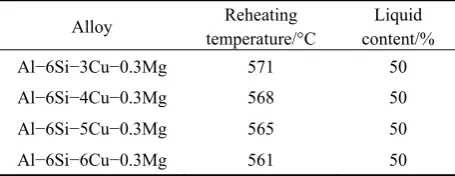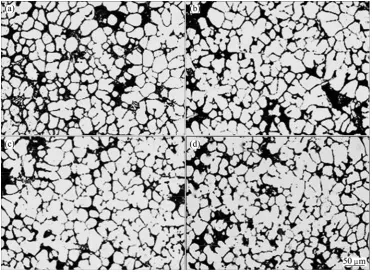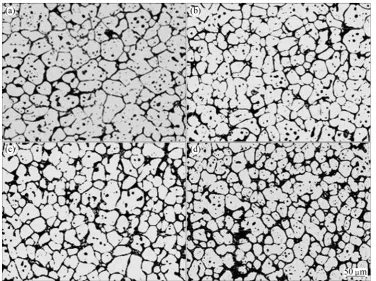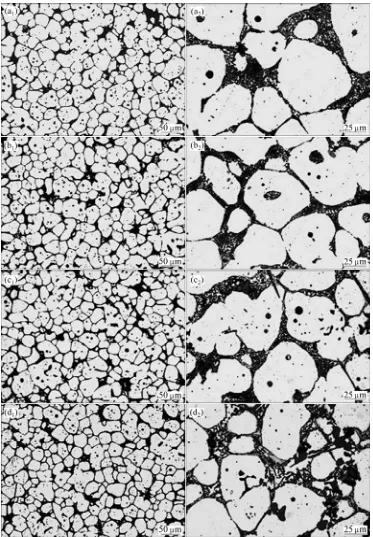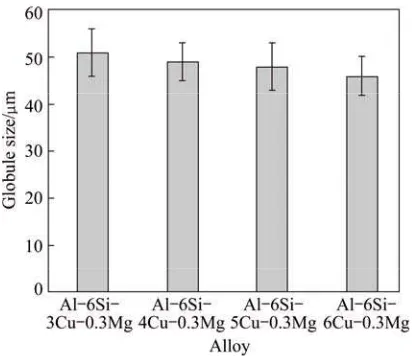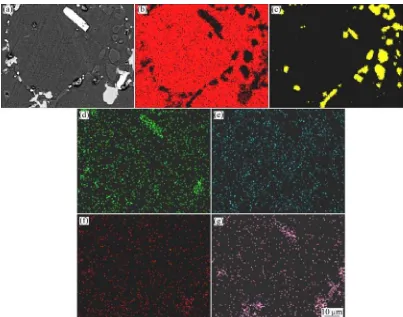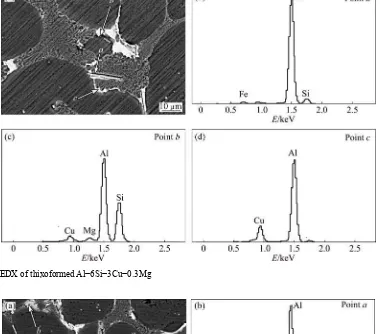Trans. Nonferrous Met. Soc. China 25(2015) 3523−3538
Influence of Cu content on microstructure and
mechanical properties of thixoformed Al
−
Si
−
Cu
−
Mg alloys
M. S. SALLEH1, 2, M. Z. OMAR1
1. Department of Mechanical and Materials Engineering, Faculty of Engineering and Built Environment, Universiti Kebangsaan Malaysia, Selangor 43600, Malaysia;
2. Department of Manufacturing Process, Faculty of Manufacturing Engineering, Universiti Teknikal Malaysia Melaka, Hang Tuah Jaya, Durian Tunggal Melaka 76100, Malaysia
Received 13 December 2014; accepted 27 July 2015
Abstract: The effects of Cu content on the microstructure and mechanical properties of thixoformed Al−6Si−хCu−0.3Mg (х= 3, 4, 5 and 6, mass fraction, %) alloys were studied. The samples were thixoformed at 50% liquid content and several of the samples were treated with the T6 heat treatment. The samples were then examined by optical microscopy (OM), scanning electron microscopy (SEM), energy dispersive X-ray (EDX) spectroscopy and X-ray diffraction (XRD) analysis, as well as hardness and tensile tests. The results show that the cooling slope casting and thixoforming process promote the formation of very fine and well distributed intermetallic compounds in the aluminium matrix and the mechanical properties of the alloys increase considerably compared with the permanent mould casting. The results also reveal that as the Cu content in the alloy increases, the hardness and tensile strength of the thixoformed alloys also increase. The ultimate tensile strength, yield strength and elongation to fracture of the thixoformed heat-treated Al−6Si−3Cu−0.3Mg alloy are 298 MPa, 201 MPa and 4.5%, respectively, whereas the values of the thixoformed heat-treated alloy with high Cu content (6%) are 361 MPa, 274 MPa and 1.1%, respectively. The fracture of the thixoformed Al−6Si−3Cu−0.3Mg alloy shows a dimple rupture, whereas in the alloy that contains the highest Cu content (6%), a cleavage fracture is observed.
Key words: Al−Si−Cu−Mg alloy; Cu content; thixoforming; T6 heat treatment; mechanical properties
1 Introduction
Thixoforming is a type of semisolid metal (SSM) processing for forming alloys in the semisolid state to near net-shaped products. Today, thixoforming has become one of the important processing techniques accepted by many manufacturers, replacing conventional casting and forging processing routes. In recent years, the need to produce a product, that is superior in mechanical properties to those using conventional casting (e.g, permanent mould casting), has drawn the attention toward SSM processing [1]. According to CAMACHO et al [2] and LIU et al [3], SSM processing for aluminium alloys is normally performed between the solidus and liquidus temperatures at 30% and 50% liquid content. For the alloy to be suitable for thixoforming, it must have a wide processing window and low sensitivity of the liquid fraction, as described by CHEN et al [4] and
SALLEH et al [5]. In contrast, aluminium alloys that have a very high sensitivity to temperature are not suitable for thixoforming [6].
Some works had been performed to investigate the thixoformability of modified commercial alloys for SSM processing. LIU et al [3] had examined the thixoformability of Al−Si−Cu and Al−Si−Cu−Mg alloys using the MTDATA thermodynamic and phase equilibrium commercial software that was combined with the MTAL database. Three criteria for thixoformability were identified and a range of alloy compositions, based on Al−Si−Cu and Al−Si−Cu−Mg, were evaluated in relation to these criteria. It was observed that the addition of up to 10% Cu in the A356 aluminium alloy resulted in an enlarged working window, as well as reduced temperature sensitivity of the liquid fraction. WU et al [7] studied the effects of Cu content on microstructure and mechanical properties of cast Al−14.5Si−0.5Mg alloys. They observed that low Cu
content (0.52%) alloy had higher ultimate tensile strength (UTS) and elongation than the high Cu (4.65%) content alloy. Nevertheless, the hardness of the low Cu alloy was lower than high Cu alloy with the values of HRB 68 and HRB 80, respectively. ZEREN et al [8] investigated the Cu addition on microstructure and hardness of near-eutectic Al−Si cast alloys. The hardness of the as-cast samples in T6 condition increased from HB 55 to HB 118, as the Cu content increased to a maximum of 5%.
According to RINCON et al [9], Al−Si−Cu−Mg aluminium alloy is commonly used in the automotive industry due to its excellent castability and corrosion resistance. This age-hardenable alloy has shown an increase in automotive uses within recent years, especially because there is a demand for lighter vehicles, as one of the important goals to improve fuel efficiency and reduce vehicle emissions, as explained by MAHMUDI et al [10]. Copper and magnesium are usually added to increase the mechanical properties of cast Al−Si alloy. During solidification, alloying elements and impurities partially form various constituent particles, including Al2Cu, Al5Cu2Mg8Si6, Al5FeSi, Mg2Si and Al8Mg3FeSi6 under different conditions, as discussed by CÁCERES et al [11] and IBRAHIM et al [12]. According to ALKAHTANI [13] and ELSEBAIE et al [14], T6 heat treatment was one of the main methods used to improve the mechanical properties of alloys that contain Cu and/or Mg elements. The effect of precipitation strengthening on the mechanical properties of these alloys is strongly dependent on the number of Cu and Mg solute atoms in the Al matrix [7].
Although the effects of Cu on the microstructure of conventional cast Al−Si−Cu−Mg alloys have been reported frequently in the literature, the work here is significant since there is yet rare report on the effects of Cu on the microstructure and mechanical properties of Al−Si−Cu−Mg subjected to thixoforming process. Therefore, in this work, an experimental work was performed to investigate the microstructural features and mechanical properties of thixoformed Al−6Si−Cu− 0.3Mg alloy with different Cu contents (3%−6%). The alloys were produced using a cooling slope casting method, before they were thixoformed in a press. The effects of T6 heat treatment on the mechanical properties and fracture behaviour of the thixoformed alloys were
then investigated.
2 Experimental
The Al−6Si−xCu−0.3Mg (x=3, 4, 5 and 6, mass fraction, %) alloys used in this work were fabricated using a conventional casting process. The chemical compositions of the alloys were determined by X-ray fluorescence (XRF) technique, as depicted in Table 1. Differential scanning calorimetry (DSC) was performed primarily to estimate the liquidus temperature and liquid fraction profile within the semisolid range of the as-cast material. The alloys were cut into small pieces (less than 25 mg) for testing using a Netzsch-STA (TG-DSC) 449 F3 simultaneous thermogravimeter. The heating rate employed was 10 °C/min in nitrogen to prevent oxidation. The experimental flow process for this work is shown in Fig. 1. Determinations of the liquid fraction with temperature for the alloys were obtained from the heat flow versus temperature curves, as shown in Fig. 2.
The alloys were subjected to the cooling slope (CS) casting processing route to obtain the thixotropic behaviour of the feedstock for thixoforming. The cooling slope casting apparatus consists of resistance furnace, 90 mm wide incline plate and stainless steel mould. The parameters (i.e, pouring temperature of 630 °C and cooling length of 400 mm) used in this work were selected based on the previous investigation with A319 aluminium alloy [15]. 1 kg of each of the respective alloys (refer to Table 1) were melted and superheated using a resistance furnace to 700 °C in an argon atmosphere and then brought down to the selected pouring temperature (630 °C) before being poured onto the surface of the plate. The tilt angle of 60° of the slope plate was selected with respect to the horizontal plane and was additionally water-cooled to increase the nucleation rate of the solid particles, to produce a globular microstructure. Its surface was coated with a thin layer of boron nitride in order to reduce sticking of the molten alloy. Subsequently, the semisolid melt was collected in a 160 °C preheated cylindrical stainless steel mould, before it was cooled down to room temperature.
A high frequency induction coil (80 kHz, 35 kW) was used to heat the cooling slope cast ingots to the semisolid temperature range as listed in Table 2. These
Table 1 Chemical compositions of studied alloys (mass fraction, %)
Alloy Si Cu Mg Mn Zn Ni Fe Cr Ti Al
Al−6Si−3Cu−0.3Mg 6.26 2.91 0.30 0.10 0.71 0.06 0.23 0.03 0.03 Bal.
Al−6Si−4Cu−0.3Mg 6.24 3.89 0.27 0.10 0.66 0.03 0.18 0.03 0.05 Bal.
Al−6Si−5Cu−0.3Mg 6.21 5.03 0.24 0.11 0.68 0.09 0.21 0.01 0.03 Bal.
Fig. 1 Process flow of experimental procedure
Table 2 Thixoforming processing parameters
temperatures were obtained from the DSC graph as shown in Fig. 2. Temperature was monitored with a K-type thermocouple inserted in a 1.5 mm diameter and 5 mm deep hole drilled at the center of each ingot. Measurements were taken to achieve rapid heating at 130 °C/min to prevent grain growth. The thixoformed processing was performed using a hydraulic cylinder press that provided a load of 20 kN. The maximum speed for the ram was 85 mm/s and the die (Fig. 3) was preheated to 350 °C. Graphite spray was used as a lubricant to reduce the stickiness between the materials and the die.
Fig. 3 Schematic diagram of die for thixoforming process
Table 3 shows the processing conditions of the studied alloys. Each of the alloy’s group was subjected to the standard T6 heat treatment (refer Condition 2 in Table 3) that was performed in a furnace equipped with a programmable temperature controller for both the solution and the aging heat treatments. The solution heat treatment was performed for 8 h at 505 °C. The solution heat-treated samples were quenched in warm water at 60 °C, followed by aging at 157 °C for 4 h. In this work, the alloy with 3% Cu was used to study the effect of thixoforming on the alloy as opposed to the conventional casting.
The microstructures were examined by Olympus optical microscopy (OM) and various phases of the samples were identified using a Carl Zeiss (EvoMa10) scanning electron microscope (SEM) equipped with
Table 3 Processing conditions of studied alloys
Alloy Condition 1 Condition 2
Al−6Si−3Cu−0.3Mg As-cast As-cast+T6
Al−6Si−3Cu−0.3Mg Thixoforming Thixoforming+T6
Al−6Si−4Cu−0.3Mg Thixoforming Thixoforming+T6
Al−6Si−5Cu−0.3Mg Thixoforming Thixoforming+T6
Al−6Si−6Cu−0.3Mg Thixoforming Thixoforming+T6
energy dispersive X-ray (EDX) spectroscopy and X-ray diffraction (XRD) analysis. The image analysis, i.e., the calculation of the shape factor (SF) and globule size (GS) of the α(Al) phase in CS casting, was performed using the Image-J software. The shape factor is defined as 4πA/P2, where P is the perimeter and A is the area of the particle, as stated by ARIF et al [16]. The average size of the primary particles is defined by CZERWINSKI [17] as [Ʃ2(Ai/π) 1/2]/N, where Ai is the area of each particle and N is the total number of particles in each image. For this experiment, the globules diameter and shape factor were measured for a minimum of 100 grains at a sample. The samples for OM and SEM were prepared by a standard technique of grinding using silicon carbide abrasive paper and then polished with a LECO microid diamond compound (6 µm, 3 µm followed by 1 µm); they were then etched for approximately 20 s with Keller’s reagent.
For the hardness test, the samples were polished with silicon carbide (SiC) abrasive paper and then with a diamond compound (3 µm). The samples were measured in Vickers units with a load of 10 kg for 10 s. The Vickers hardness value was obtained using an average of at least 10 measurements. From the as-cast, thixoformed and thixoformed T6 samples, cylindrical tensile specimens of 4 mm in diameter and 20 mm in length were machined according to the ASTM:E8M standard. Three samples were tested for each group to obtain reliable tensile tested results. Tensile tested was carried out at room temperature using a 100 kN Zwick Roell universal testing machine (UTM). An extensometer was placed on the gauge length in order to measure the elongation values all the way to fracture. The yield stress was based on a 0.2% plastic strain offset. The fracture surfaces of the tensile samples were investigated using a Carl Zeiss SEM. By these means, the morphologies of the fractured surface and other defects were determined.
3 Results and discussion
3.1 Cooling slope casting
Al−Si eutectic, distributed homogenously throughout the sample. Figure 5 demonstrates the optical micrographs of the alloys after cast over a cooling slope plate. The changes in the α(Al) morphology upon cooling slope casting were remarkable and the dendritic microstructure
was almost replaced by the α(Al) globule and rosettes. According to BIROL and AKDI [18], the shear driven melt flow along the cooling slope plays an important role to change the morphology of the α(Al) particles. When the molten alloy flowed over the slope plate, the
Fig. 4 Microstructures of permanent mould cast for Al−6Si−3Cu−0.3Mg (a), Al−6Si−4Cu−0.3Mg (b), Al−6Si−5Cu−0.3Mg (c) and Al−6Si−6Cu−0.3Mg (d)
temperature of the molten alloy falls below the liquidus temperature, generating the α(Al) crystals, which were detached from the slope. Afterwards, these crystals were trapped in the following melt where they flowed continuously into a heating mould, and subsequently became globular in the mould. As mentioned in Section 2, a pouring temperature of 630 °C with a cooling length of 400 mm is optimal for feedstock preparation of the alloys to transform the fully dendritic microstructure into near globular one with a shape factor of about 0.72 to 0.78 and a globule size of about 30 to 35 μm.
3.2 Isothermal heating and quenching experiment Researchers have previously reported that 30%−50% liquid content was needed during thixoforming process [3,19]. The temperatures for the alloys were estimated from DSC as listed in Table 2. In this case, 50% liquid content was selected (above the knee in Fig. 2) for thixoforming, to avoid the unstable melting of the eutectic phase. When all of the eutectic phases were melted, the remaining of α(Al) phase was more controllable and suitable for thixoforming. The microstructures of the cast over a cooling slope plate after being isothermally held at their respective temperatures (listed in Table 2) are shown in Fig. 6. The temperatures which acted as a thixoforming soaking temperature were believed to be the appropriate temperatures to obtain a spherical morphology of α(Al) during thixoforming. The Al phase which remained
unmelted in the semisolid temperature appeared as grey solid particles in these micrographs, while the dark regions showed a rapidly quenched eutectic Si phase which was completely molten in the end of the isothermal treatment. It was observed that the α(Al) had completely changed into a globular morphology in only 5 min. Distribution of α(Al) surrounded with eutectic was apparently homogenous and dominated by the globular microstructure of solid particles. The average globule size in the samples after being isothermally held at temperatures corresponded to 50% liquid was much coarser, implying an appropriate and sufficient reheating temperature during thixoforming.
3.3 Thixoforming and microstructure analysis
Samples taken from the ingots cast over the cooling slope plate were machined and thixoformed after being heated in situ in a compression press. As shown in Fig. 7, the thixoformed samples exhibited a uniform distribution of α(Al) globule, and no evidence of macro and micro porosities were detected, while the α(Al) globules were smaller than those observed in the isothermal samples. This is due to the appropriate heating rates used in thixoforming that helped to reduce the size of α(Al) globules. However, the difference in globule sizes (Fig. 8) of the thixoformed alloys is trivial, indicating that the Cu addition in Al−6Si−3Cu−0.3Mg alloy does not have a significant effect on refining the size of α(Al) globules. It was also observed that a small part of the eutectic was
Fig. 7 Microstructures of thixoformed samples: (a1,a2) Al−6Si−3Cu−0.3Mg; (b1,b2) Al−6Si−4Cu−0.3Mg; (c1,c2) Al−6Si−5Cu− 0.3Mg; (d1,d2) Al−6Si−6Cu−0.3Mg
entrapped inside the globules. EDX analysis revealed that the composition of the globule consisted of Al and a very small amount of Cu (less than 1%). This is because most of the alloying elements were contained in the eutectic region.
Some of the thixoformed parts were heat treated with the T6 heat treatment, as illustrated in Fig. 9. The T6 heat treatment had an impact on the microstructure,
Fig. 8 Effect of Cu content on globule size of thixoformed alloys
Figures 10 and 11 represent the SEM-EDX elemental mapping of Al−6Si−6Cu−0.3Mg alloy in thixoformed and thixoformed-T6 conditions, respectively. In thixoformed condition, Si Cu, Mg and Fe were intensified in certain regions within the α(Al) globules. However, Mn particles showed a homogenous distribution in the structure. In thixoformed-T6 condition, Si was spheroidised in certain region within the globules and Cu, Mg, Fe and Mn were distributed homogenously
in the sample. It should be noted that the T6 heat treatment improves not only the distribution of the
alloying elements, but also the morphology of the eutectic Si, which may have improved the mechanical properties of the alloys [21]. Figures 12−14 display the SEM images and EDX patterns of the thixoformed Al−6Si−3Cu−0.3Mg, Al−6Si−4Cu−0.3Mg and Al−6Si− 6Cu−0.3Mg, respectively. The EDX analyses results indicate the existence of a small amount of Si, Cu, Mg and Fe elements in the Al matrix as evident from the SEM and EDX patterns. These elements accumulated heavily in the eutectic phase at the grain boundaries. It was also confirmed that white and dark colour particles (needle-like) in Figs. 12−14 are Cu phase and Fe intermetallic compound, respectively. Cu phases were more evenly distributed at the grain boundaries between the globules, which finally could improve the mechanical properties of the alloys. In contrast, a needle-like Fe intermetallics which existed in the eutectic Si degraded the tensile properties of the alloys, especially for the elongation to fracture [22].
Figures 15 and 16 illustrate the SEM images and EDX patterns for thixoformed alloy Al−6Si−3Cu−0.3Mg and Al−6Si−6Cu−0.3Mg, respectively in T6 condition. The EDX analyses results show the existence of a small amount of Si, Cu, Mg and Fe elements in the Al matrix.
It was confirmed from XRD results depicted in Fig. 17 that the Al2Cu, Al5Cu2Mg8Si6 and β-Al5FeSi phases existed in the alloys. Besides that, the Si particles had completely transformed into a spheroidal form and the distribution had improved relative to those of the as-thixoformed sample. Increasing the Cu content led to
Fig. 10 SEM−EDX elemental mapping of thixoformed Al−6Si−6Cu−0.3Mg: (a) SEM image; (b) Al; (c) Si; (d) Mg; (e) Cu; (f) Mn; (g) Fe
Fig. 12 SEM−EDX of thixoformed Al−6Si−3Cu−0.3Mg
Fig. 13 SEM−EDX of thixoformed alloy Al−6Si−4Cu−0.3Mg
the increase in the amount of precipitate-hardening phase resulting with the increase in strength. It was noted that the precipitate-hardening phase of Al−6Si−6Cu−0.3Mg was much higher than that of Al−6Si−3Cu−0.3Mg alloy and more evenly distributed at grain boundaries, which could improve the mechanical properties.
3.4 Mechanical properties
Fig. 14 SEM−EDX of thixoformed alloy Al−6Si−6Cu−0.3Mg
Fig. 15 SEM−EDX of thixoformed alloy Al−6Si−3Cu−0.3Mg after T6 treatment (arrow a: Al5Cu2Mg8Si6; arrow b: β-Al5FeSi and arrow c: Al2Cu)
Al−6Si−4Cu−0.3Mg, Al−6Si−5Cu−0.3Mg and Al−6Si− 6Cu−0.3Mg, the hardnesses increased to HV (109.1±2.3), HV (118.2±3.0) and HV (124.5±3.2), respectively. Nevertheless, the hardness of the thixoformed alloys increased significantly after the T6 heat treatment. During the solution treatment, several of the alloying
Fig. 16 SEM−EDX of thixoformed alloy Al−6Si−6Cu−0.3Mg after T6 treatment (arrow a: Al5Cu2Mg8Si6; arrow b: β-Al5FeSi; arrow c: Al2Cu)
Fig. 17 XRD patterns of thixoformed alloys after T6 treatment: (a) Al−6Si−3Cu−0.3Mg; (b) Al−6Si−4Cu−0.3Mg; (c) Al−6Si− 5Cu−0.3Mg; (d) Al−6Si−6Cu−0.3Mg
of the strengthening phase increased the hardness of the alloys. It can be seen from Fig. 18 that the hardness of the high Cu (6%) content alloy attained the hardness value as high as HV (142±3.0).
The tensile properties for the alloys were compared in Fig. 19. The result of the thixoformed Al−6Si−3Cu− 0.3Mg alloy was evidently increased when compared with the as-cast alloy. In thixoformed Al−6Si−3Cu− 0.3Mg, the UTS, YS and elongation to fracture were 241 MPa, 176 MPa and 3.2%, respectively. For the thixoformed alloys Al−6Si−4Cu−0.3Mg, Al−6Si− 5Cu−0.3Mg and Al−6Si−6Cu−0.3Mg, the UTS values
Fig. 18 Comparison of hardnesses of various alloys (before and after T6 treatment) produced via permanent mould casting and thixoforming
increased slightly to 258, 271 and 287 MPa, respectively, whereas the YS values increased significantly to 204, 238 and 253 MPa, respectively. The elongation to fracture sharply decreased throughout the thixoformed samples. For the thixoformed alloys Al−6Si−4Cu− 0.3Mg, Al−6Si−5Cu−0.3Mg and Al−6Si−6Cu−0.3Mg, the elongations decreased to 2.8%, 1.2% and 0.8%, respectively.
Fig. 19 Comparison of strength of various alloys produced via permanent mould casting and thixoforming of Al−6Si−xCu− 0.3Mg
increased to 233 MPa, 154 MPa and 2.8%, respectively after the T6 treatment. For thixoformed alloys Al−6Si−3Cu−0.3Mg, Al−6Si−4Cu−0.3Mg, Al−6Si− 5Cu−0.3Mg and Al−6Si−6Cu−0.3Mg, the UTS values were significantly increased to 298, 314, 341 and 361 MPa, respectively, while the yield strength values also increased to 201, 236, 258 and 274 MPa, respectively. The elongation to fracture of the alloys was decreased from 4.5% in Al−6Si−3Cu−0.3Mg to 1.1% in Al−6Si−6Cu−0.3Mg. The highest UTS and YS values were obtained in the thixoformed alloy Al−6Si− 6Cu−0.3Mg, while good elongation to fracture (Fig. 20) was obtained from the thixoformed samples of Al−6Si−3Cu−0.3Mg. Alloys with high Cu content showed the lowest ductility since the Cu solute atoms enhanced the precipitation hardening of the Al matrix and also increased the content of Al2Cu phase [11]. The ductility was also decreased when the precipitation particles were large or elongated. Besides that, the results from Fig. 19 show a significant improvement in the mechanical properties especially tensile strength of thixoformed Al−6Si−3Cu−0.3Mg sample in comparison with permanent mould casting sample. It also shows that the thixoforming process was extremely beneficial for improving the tensile elongation before fracture. This enhancement was due to the combination effects of morphological changes in the shape of eutectic silicon particles. The results from this work revealed that the mechanical properties of the aluminium alloys can be improved by the microstructural uniformity caused by the sphericity of Al globules and contiguity of the eutectic phase, reduction of α(Al) size and homogenous distribution of intemetallic phase caused by thixoforming processing.
It was reported by TAVITAS-MEDRANO et al [23] that the A319 alloy that is used for fabrication of automotive engine blocks and cylinder heads should have a yield strength of 250 MPa and ultimate tensile strength of 300 MPa with elongation to fracture of 1%. As shown in Figs. 20 and 21, the tensile properties of thixoformed alloys Al−6Si−5Cu−0.3Mg and Al−6Si− 6Cu−0.3Mg in T6 condition had achieved the minimum requirement of automotive cylinder head alloys. Hence, the results in this work indicated the suitability of these two alloys for automotive application via thixoforming processing route.
Fig. 20 Comparison of elongation of various alloys (before and after T6 treatment) produced via permanent mould casting and thixoforming
Numerous research works, such as CERRI et al [24] and RINCON et al [9] had proven that the β-Al5FeSi phase reduces the tensile properties of Al−6Si−3Cu− 0.3Mg aluminium alloys. In this work, the β-Al5FeSi intermetallic phase was unable to transform into the π-Al8Mg3FeSi5 phase. This phase had a compact morphology and was less harmful than acicular β-Al5FeSi, as explained by SHABESTARI and PARSHIZFARAD [22]. This was due to the amount of Mg, which tends to form Al5Cu2Mg8Si5 rather than Al8Mg3FeSi5. HWANG et al [25] reported that adding 0.65% Mn to cast A319 alloy resulted in changes in the morphology of acicular β-Al5FeSi to the
α-Al15(Fe,Mn)3Si2 phase, thus improving the elongation to fracture of the alloy. Therefore, the mole ratio of Mn to Fe equivalent to 1:2, as suggested by CERRI et al [24] could improve the elongation to fracture of the thixoformed alloys.
3.5 Fracture surface analysis
Figure 21 presents the SEM fractographs of as-cast and thixoformed alloys with different Cu contents. As observed in the fractographs, the as-cast sample failed in a brittle manner, as shown by the fracture of long Si particles (see red arrow in Fig. 21(a)), while the thixoformed Al−6Si−3Cu−0.3Mg exhibited a mix mod fractures (ductile and cleavage fracture), as evidenced by the small number of dimpled structure (see red arrow in Figs. 21(b) and (c)) in the samples. However, the thixoformed alloys, Al−6Si−4Cu−0.3Mg, Al−6Si−5Cu− 0.3Mg and Al−6Si−6Cu−0.3Mg showed a brittle fracture, as evidenced by the cleavage structure (see red arrow in Figs. 21(d) and (e)) in the alloys.
Figure 22 demonstrates the SEM fractographs of the tensile fractured samples in the T6 heat treatment. It can be seen from Fig. 22(a), the presence of the shrinkage porosity (shown by a red arrow) in the Al−6Si−3Cu− 0.3Mg as-cast sample resulted from fracture nucleation sites, as discussed by FADAVI BOOSTANI and TAHAMTAN [26]. It was also revealed that clustered pores (shown in red circles) in this sample might have reduced the mechanical properties of the alloy by
creating an easy path for crack propagation, leading to intercellular fracture. In comparison, the fractograph surface of thixoformed Al−6Si−3Cu−0.3Mg in the T6 condition (illustrated in Fig. 22(b)) revealed that tensile fracture occurred by void initiation at the silicon particles; thereupon, microvoids joined together by dimpled rupture (see red arrows) of the α(Al) phase in between, which enhanced the tensile ductility. It is also important to notice that, the T6 heat treatment was able to improve the elongation to fracture from 3.2% (before T6 treatment) to 4.5% (after T6 treatment) and the alloys showed a ductile fracture as evidence by the dimpled rupture. In the case of thixoformed Al−6Si−4Cu−0.3Mg in T6 condition, as shown in Fig. 22(c), it was observed that the fracture surface contained large microvoids that reduced the ductility of the alloy (the elongation was 3.4%). In Figs. 22(d) and (e), the fractographs of Al−6Si−5Cu−0.3Mg and Al−6Si−6Cu−0.3Mg presented a cleavage rupture resulted from brittle fracture behaviour. The elongation to fracture of Al−6Si−5Cu− 0.3Mg and Al−6Si−6Cu−0.3Mg were reduced to 1.5% and 1.1%, respectively.
Fig. 22 SEM fractographs of thixoformed samples after T6 heat treatment: (a) Cast Al−6Si−3Cu−0.3Mg; (b) Thixoformed Al−6Si− 3Cu−0.3Mg; (c) Thixoformed Al−6Si−4Cu−0.3Mg; (d) Thixoformed Al−6Si−5Cu−0.3Mg; (e) Thixoformed Al−6Si−6Cu−0.3Mg
4 Conclusions
1) The thixoformed Al−6Si−xCu−0.3Mg (x=3, 4, 5, 6) samples thus produced displayed a uniform dispersion of fine Si particles in a homogenous α(Al) matrix. Cu addition does not have a significant effect on refining the size of the α(Al) globules.
2) Cu addition into the Al−6Si−3Cu−0.3Mg alloy does not produce any impact on the formation of the Al8Mg3FeSi5 phase that is less harmful than the
β-Al5FeSi phase. This is because all of the Mg atoms were used to form the Al5Cu2Mg8Si5 phase instead of Al8Mg3FeSi5 phase.
3) In parallel to the increase in the Cu content, the hardness and tensile strength of the thixoformed alloys increased and the elongation decreased. The T6 heat treated samples of high Cu alloy displayed higher ultimate and yield strengths, as high as 361 MPa and 274 MPa, respectively. However, the elongation to fracture was reduced to 1.1%. But, these have fulfilled the minimum requirements of certain automotive applications, such as the cylinder heads.
4) The fracture of thixoformed Al−6Si−3Cu−0.3Mg
in the T6 condition showed a dimple rupture, whereas it showed a combination of dimple and cleavage ruptures in the highest Cu content alloy.
Acknowledgments
The authors would like to thank Universiti Teknikal Malaysia Melaka (UTeM) and the Ministry of Education Malaysia for financial support of this study. Much appreciation also goes to Universiti Kebangsaan Malaysia (UKM) for the financial support under research grants GUP-2012-040 and AP-2012-014.
References
[1] ABEDI A, SHAHMIRI M, AMIR ESGANDARI B, NAMI B.
Microstructural evolution during partial remelting of Al−Si alloys containing different amounts of magnesium [J]. Journal of Materials Science & Technology, 2013, 29: 971−978.
[2] CAMACHO A M, ATKINSON H V, KAPRANOS P, ARGENT B B. Thermodynamic predictions of wrought alloy compositions amenable
to semi-solid processing [J]. Acta Materialia, 2003, 51: 2319−2330. [3] LIU D, ATKINSON H V, JONES H. Thermodynamic prediction of
thixoformability in alloys based on the Al−Si−Cu and Al−Si−Cu−Mg systems [J]. Acta Materialia, 2005, 53: 3807−3819.
[4] CHEN Gang, DU Zhi-ming, CHENG Yuan-sheng. Effect of
properties of thixoformed Al−Cu−Si−Mg alloy [J]. Materials & Design, 2012, 35: 774−781.
[5] SALLEH M S, OMAR M Z, SYARIF J. The effects of Mg addition on the microstructure and mechanical properties of thixoformed Al−5%Si−Cu alloys [J]. Journal of Alloys and Compounds, 2015, 621: 121−130.
[6] ATKINSON H V. Modelling the semisolid processing of metallic alloys [J]. Progress in Materials Science, 2005, 50: 341−412. [7] WU Chih-ting, LEE Sheng-long, HSIEH Meng-hsiung, LIN
Jing-chie. Effects of Cu content on microstructure and mechanical properties of Al−14.5Si−0.5Mg alloy [J]. Materials Characterization, 2010, 61: 1074−1079.
[8] ZEREN M, KARAKULAK E, GÜMÜŞ S. Influence of Cu addition on microstructure and hardness of near-eutectic Al−Si−xCu-alloys [J]. Transactions of Nonferrous Metals Society of China, 2011, 21(7): 1698−1702.
[9] RINCON E, LOPEZ H F, CISNEROS M M, MANCHA H. Temperature effects on the tensile properties of cast and heat treated aluminum alloy A319 [J]. Materials Science and Engineering A, 2009, 519: 128−140.
[10] MAHMUDI R, SEPEHRBAND P, GHASEMI H M. Improved properties of A319 aluminum casting alloy modified with Zr [J]. Materials Letters, 2006, 60: 2606−2610.
[11] CÁCERES C H, SVENSSON I L, TAYLOR J A. Strength-ductility behaviour of Al−Si−Cu−Mg casting alloys in T6 temper [J]. International Journal of Cast Metals Research, 2003, 155: 531−543. [12] IBRAHIM M F, SAMUEL E, SAMUEL A M, AL-AHMARI A M A,
SAMUEL F H. Metallurgical parameters controlling the microstructure and hardness of Al−Si−Cu−Mg base alloys [J]. Materials & Design, 2011, 32: 2130−2142.
[13] ALKAHTANI S. Mechanical performance of heat treated 319 alloys as a function of alloying and aging parameters [J]. Materials & Design, 2012, 41: 358−369.
[14] ELSEBAIE O, MOHAMED A M A, SAMUEL A M, SAMUEL F H, AL-AHMARI A M A. The role of alloying additives and aging treatment on the impact behavior of 319 cast alloy [J]. Materials & Design, 2011, 32: 3205−3220.
[15] SALLEH M S, OMAR M Z, SYARIF J, ALHAWARI K S, MOHAMMED M N. Microstructure and mechanical properties of thixoformed A319 aluminium alloy [J]. Materials & Design, 2014, 64:
142−152.
[16] ARIF M A M, OMAR M Z, MUHAMAD N, SYARIF J, KAPRANOS P. Microstructural evolution of solid-solution-treated Zn−22Al in the semisolid state [J]. Journal of Materials Science & Technology, 2013, 29: 765−774.
[17] CZERWINSKI F. On the generation of thixotropic structures during melting of Mg−9%Al−1%Zn alloy [J]. Acta Materialia, 2002, 50: 3265−3281.
[18] BIROL Y, AKDI S. Cooling slope casting to produce EN AW 6082 forging stock for manufacture of suspension components [J]. Transactions of Nonferrous Metals Society of China, 2014, 24(6): 1674−1682.
[19] BIROL Y. Forming of AlSi8Cu3Fe alloy in the semi-solid state [J].
Journal of Alloys and Compounds, 2009, 470: 183−187.
[20] BIROL Y. Semi-solid processing of the primary aluminium die casting alloy A365 [J]. Journal of Alloys and Compounds, 2009, 473: 133−138.
[21] BIROL Y. Evolution of globular microstructures during processing of aluminium slurries [J]. Transactions of Nonferrous Metals Society of China, 2013, 23(1): 1−6.
[22] SHABESTARI S G, PARSHIZFARD E. Effect of semi-solid forming on the microstructure and mechanical properties of the iron containing Al−Si alloys [J]. Journal of Alloys and Compounds, 2011, 509: 7973−7978.
[23] TAVITAS-MEDRANO F J, GRUZLESKI J E, SAMUEL F H, VALTIERRA S, DOTY H W. Effect of Mg and Sr-modification on the mechanical properties of 319-type aluminum cast alloys subjected to artificial aging [J]. Materials Science and Engineering A, 2008, 480: 356−364.
[24] CERRI E, EVANGELISTA E, SPIGARELLI S, CAVALIERE P, DERICCARDIS F. Effects of thermal treatments on microstructure and mechanical properties in a thixocast 319 aluminum alloy [J]. Materials Science and Engineering A, 2000, 284: 254−260. [25] HWANG J Y, DOTY H W, KAUFMAN M J. The effects of Mn
additions on the microstructure and mechanical properties of Al−Si−Cu casting alloys [J]. Materials Science and Engineering A, 2008, 488: 496−504.
[26] FADAVI BOOSTANI A, TAHAMTAN S. Effect of a novel thixoforming process on the microstructure and fracture behavior of A356 aluminum alloy [J]. Materials & Design, 2010, 31: 3769−3776.
铜含量对触变成形
Al
−
Si
−
Cu
−
Mg
合金
显微组织与力学性能的影响
M. S. SALLEH1,2, M. Z. OMAR1
1. Department of Mechanical and Materials Engineering, Faculty of Engineering and Built Environment, Universiti Kebangsaan Malaysia, Selangor 43600, Malaysia;
2. Department of Manufacturing Process, Faculty of Manufacturing Engineering, Universiti Teknikal Malaysia Melaka, Hang Tuah Jaya, Durian Tunggal Melaka 76100, Malaysia


